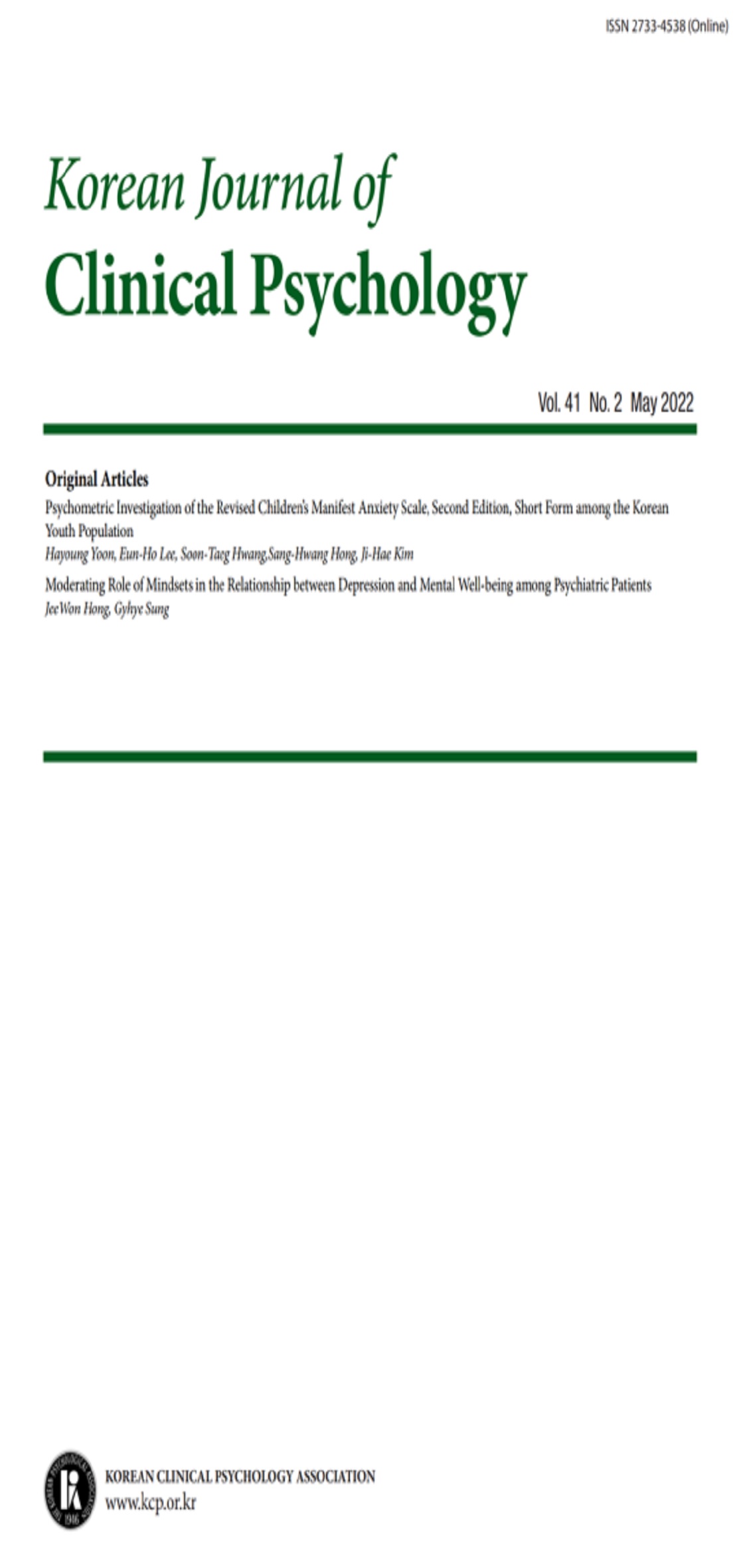open access
메뉴
open access
메뉴 E-ISSN : 2733-4538
E-ISSN : 2733-4538
본 연구는 한국판 MMPI-2 표준화과정을 기술했고 한국판 MMPI-2의 신뢰도와 타당도를 미국규준집단의 자료와 비교하여 검증했다. MMPI-2의 규준집단(남자 651명, 여자 701명)은 <2000년 인구 및 주택 총조사>에 기초하여, 19세 이상의 성인을 대상으로 인구 비례에 따라 표집하였는데, 통계검증 결과 성별, 연령, 교육수준, 지역, 거주지에 준거해 2000년 한국국민을 잘 대표하였다. 척도의 원점수는 적절한 T 점수 (동형, 선형)로 전환되었으며 본 연구에서는 동형 T 점수로 전환된 임상척도와 내용척도의 결과를 제시하였다. 이들 척도의 동형 T 점수 편포치가 선형 T 점수의 편포치보다 더 고르게 나타났는데 이 결과는 MMPI-2의 새로운 T 점수 전환법인 동형 T 가 척도간 백분위를 동등하게 해준다는 점을 보여준다. 한국집단의 척도 점수는 미국집단보다 높았으며 문항반응 빈도에서 한미간 많은 차이를 보였다. 하지만 MMPI-2 문항 중 남녀 집단을 가장 잘 변별해주는 문항은 한미 두 나라에서 유사하게 나타났다. MMPI-2의 기본척도의 요인분석결과 3, 4 요인 구조에서 한국남녀의 요인구조는 미국남녀의 요인구조보다 훨씬 더 유사했다. 한국 MMPI-2 척도의 검사-재검사 신뢰도와 내적 일치도는 미국 자료와 상당히 일치했다. 임상척도와 배우자 평가지 문항의 상관도는 MMPI-2의 외적타당도를 입증해주는 중요한 결과이었다. 이러한 결과들은 한국판 MMPI-2가 신뢰롭고 타당한 검사로서 쓰일 수 있는 예비증거를 제시한다고 하겠다.
The purpose of this study was to present the Korean MMPI-2 Standardization process and provide psychometric properties of the Korean MMPI-2 via comparisons with American data. The normative sample of the Korean MMPI-2 was selected based on 2000 Korean Census data and found to be representative of Korean population in terms of geographical region, place of residence, age composition, and education level. Raw scale scores were converted to appropriate T scores (uniform and linear T) using Korean norms. Less variability in skewness across uniform T scores for the clinical and content scales indicated that uniform T scores are more percentile comparable across scales than the linear T scores. When raw scores are converted to T scores using American norms, mean scores were very elevated, with an average of one standard deviation separation between Korean and American samples. Item endorsement differences between Koreans and Americans were also large, The internal structure of the MMPI-2 basic scales showed that both for the three-factor and the four-factor solution, Korean men and women showed better convergence than American men and women. Item endorsement differences between Koreans and Americans were large, but endorsement differences between Korean men and women were very similar to those between American men and women. Test-retest and internal consistency results indicated that the stability and internal consistency of MMPI-2 scales were comparable with results obtained in American normative samples. Behavioral correlates for the MMPI-2 clinical scales derived from the spouse ratings were informative concerning the validity of the Korean MMPI-2 clinical scales. In sum, these initial findings provide promising results regarding the cross-cultural equivalence of the Korean MMPI-2.
(1980) Introduction to methodology Handbook of cross-cultural psychology,
(1996) International adaptations of the MMPI-2: A handbook of research and clinical applications (Ed.), University of Minnesota Press.
(1989) Manual for the Restandardized Minnesota Multiphasic Personality Inventory University of Minnesota Press,
(2001) MMPI-2 manual for administration, scoring, and interpretation (Rev. ed.). , University of Minnesota Press.
(1990) Development and use of the MMPI-2 content scales University of Minnesota Press,
(2005) Cross-cultural applications of the MMPI-2 Kong and the People's Republic of China., American Psychological Association
(1976) A handbook of cross-cultual MMPI research University of Minnesota Press,
(1991) An infrequency scale for the Chinese MMPI,
(1996) The Chinese MMPI-2: Research and applications in Hong Kong and the People's Republic of China., University of Minnesota Press.
(1988) Statistical power analysis for the behavioral sciences,
(2000) The MMPI: A practical guide(3rd ed.). , Oxford University Press
(1993) The use of the MMPI-2 in Korea University of Minnesota, Unpublished doctoral dissertation
(1996) The Korean MMPI-2., University of Minnesota Press.
(1988) Profiting from controversy:Lessons from the person- situation debate,
(2001) 2000 population and housing census report, Korea National Statistical Office.
(1994) The counterpoint of personality assessment:Self-reports and observer ratings,
(1989) Equivalence of cross- cultural data:An overview of basic issues,
(1986) Making inferences from cross-cultural data Field methods in cross-cultural research, Sage Publications
(1996) Adaptation and validation of the Japanese MMPI-2., University of Minnesota Press.
(1992) The new Uniform T scores for the MMPI-2,
(2003) MMPI-2 restructured clinical (RC) scales: Development, validation, and interpretation. , University of Minnesota Press
(1951) A method for synthesis of factor analysis studies Department of the Army,
(2000) Methodological issues in psychological research on culture ,
(1955) The matching of two sets of factors,
(1955) The matching of two sets of factors,
